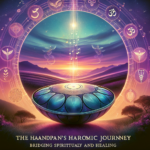Musical meditation has fascinated people for centuries. With the modern rise of mindfulness and wellness practices, it takes on even greater significance. One of the more intriguing forms of musical meditation is the one championed by Handpan Guru, a master of the handpan. This article delves into the secrets behind Handpan Guru’s unique musical meditation techniques.
What is a Handpan?
The handpan is a relatively new instrument, invented in the early 21st century. It resembles a UFO or an inverted steel drum and produces ethereal, melodious tones. The instrument consists of two metal hemispheres welded together to form a convex shape with a central note etched in the middle and several other notes surrounding it.
The handpan’s unique soundscape makes it an ideal instrument for meditation and relaxation. When played skillfully, it creates an almost hypnotic, trance-like state conducive to deeper reflection and mindfulness.
The Significance of Musical Meditation
Music has been used as a tool for meditation and relaxation for ages. Various cultures have incorporated musical elements into their spiritual and meditative practices. By integrating music into meditation, individuals can enhance their focus, emotional state, and overall well-being.
The vibration and sound frequencies of musical instruments, including the handpan, can influence our brainwaves. This phenomenon helps us achieve a meditative state more efficiently. By incorporating deliberate breathing techniques, rhythmic patterns, and mindful listening, Handpan Guru takes musical meditation to a new level.
Understanding Handpan Guru’s Techniques
Handpan Guru combines traditional meditation practices with the soothing sounds of the handpan. Let’s explore some of the core techniques used by Handpan Guru in his musical meditation sessions:
1. Breath Control
Breath control is fundamental to many meditative practices, and Handpan Guru is no exception. The handpan player synchronizes their breathing with their playing, creating a seamless flow of air and sound. This connection deepens the meditative experience, making it easier to focus and relax.
2. Rhythmic Patterns
One of the critical elements of Handpan Guru’s musical meditation is the use of rhythmic patterns. The deliberate, recurring rhythms and sequences played on the handpan create a structured yet fluid soundscape. Listeners often find themselves entranced by these patterns, easing into a deeper meditative state.
3. Mindful Listening
Handpan Guru emphasizes the importance of mindful listening. During musical meditation sessions, participants are encouraged to listen actively and focus on each note and rhythm. This practice promotes heightened awareness and fosters a deeper connection with the music and the moment.
4. Intuitive Playing
Rather than relying solely on memorized compositions, Handpan Guru uses a more intuitive approach. This method allows for spontaneous expression, ensuring that each session is unique. The handpan player’s ability to adapt in real-time creates a dynamic and engaging experience for practitioners.
5. Emotional Expression
Music is a powerful conduit for emotion, and Handpan Guru taps into this potential fully. The handpan’s resonant tones enable the expression of a wide range of emotions, from joy and tranquility to sorrow and introspection. By allowing emotions to flow naturally, participants can achieve a cathartic release, enhancing their meditative practice.
The Structure of a Handpan Guru Meditation Session
A typical Handpan Guru meditation session comprises several stages, each designed to lead participants through a progressive journey of relaxation and self-discovery. Let’s break down the structure of a session:
1. Preparation
The session begins with participants finding a comfortable position, either seated or lying down. Handpan Guru encourages everyone to tune in to their breath, grounding themselves in the present moment. This preparation phase sets the tone for the rest of the session.
2. Introduction to the Instrument
In this phase, Handpan Guru introduces the handpan, often by playing a few simple notes and rhythms. This acquaints participants with the instrument’s distinct sound and helps them transition into a more focused state of mind.
3. Guided Breathwork
The next phase involves guided breathwork exercises. These exercises are synchronized with the handpan’s rhythms, facilitating a harmonious blend of breath and sound. This practice encourages deeper, diaphragmatic breathing, which is essential for relaxation and stress reduction.
4. Main Meditation
The core of the session features an extended period of musical meditation. Handpan Guru plays continuous, flowing melodies, incorporating rhythmic patterns and intuitive playing techniques. Participants are encouraged to listen mindfully, allowing the music to guide their thoughts and emotions.
5. Closing and Integration
The session concludes with a gradual return to normal awareness. Handpan Guru plays softer, slower melodies, transitioning participants out of their meditative state. This phase often includes a brief moment of silence, providing space for reflection and integration.
The Benefits of Handpan Musical Meditation
Handpan musical meditation offers a range of benefits, encompassing physical, emotional, and psychological well-being. Here are some of the key advantages:
1. Stress Reduction
The calming sounds of the handpan, combined with the meditative practice, significantly reduce stress levels. The rhythmic patterns and soothing melodies work in tandem with breath control to lower cortisol levels and promote relaxation.
2. Enhanced Focus
Musical meditation sharpens focus and concentration. By practicing mindful listening and engaging with the music, participants train their minds to remain present, which can translate to improved cognitive function in daily life.
3. Emotional Balance
The handpan’s resonant tones facilitate emotional expression and release. Participants often experience a sense of catharsis, helping to balance their emotional state and process feelings more effectively.
4. Improved Sleep
Regular musical meditation can enhance sleep quality. The relaxation induced by the handpan’s soothing sounds can make it easier to fall asleep and enjoy restful, uninterrupted sleep.
5. Spiritual Connection
For many, musical meditation fosters a deeper spiritual connection. The ethereal tones of the handpan create a sense of transcendence, allowing participants to access higher states of consciousness and spiritual insight.
Conclusion
Handpan Guru’s musical meditation techniques offer a unique and profound way to experience meditation and mindfulness. By blending breath control, rhythmic patterns, mindful listening, intuitive playing, and emotional expression, Handpan Guru creates a dynamic and transformative journey for participants. The benefits of this practice are far-reaching, enhancing stress reduction, focus, emotional balance, sleep quality, and spiritual connection. Whether you are a seasoned meditator or new to the practice, Handpan Guru’s musical meditation techniques provide a valuable tool for enhancing your well-being.
FAQs
1. What is the primary difference between handpan musical meditation and traditional meditation practices?
The primary difference lies in the use of the handpan instrument to enhance the meditative experience. The handpan’s soothing and rhythmic tones can help participants achieve a meditative state more efficiently than traditional silent or guided meditations. The music adds a dynamic element that can make the practice more engaging and accessible.
2. Do I need any musical knowledge or experience to participate in handpan musical meditation?
No previous musical knowledge or experience is required to participate in handpan musical meditation. The practice is designed to be accessible to all, regardless of musical background. The focus is on mindful listening and relaxation rather than musical proficiency.
3. How often should I practice handpan musical meditation to see benefits?
The frequency of practice can vary based on individual needs and preferences. However, many practitioners find that engaging in handpan musical meditation several times a week yields significant benefits. Consistency is key, so try to incorporate the practice regularly into your routine.
4. Can handpan musical meditation be combined with other forms of meditation or mindfulness practices?
Absolutely. Handpan musical meditation can complement other forms of meditation and mindfulness practices. It can be integrated into a broader wellness routine, enhancing existing practices and offering a fresh and engaging way to deepen your meditative experience.
5. Where can I find a Handpan Guru or similar musical meditation sessions?
Handpan Gurus and similar practitioners may offer sessions in various settings, including yoga studios, wellness centers, and online platforms. Additionally, many handpan players share their music through online videos and streaming services, allowing you to experience the benefits of musical meditation from the comfort of your home. It may be helpful to search for local or virtual events to find a session that resonates with you.





